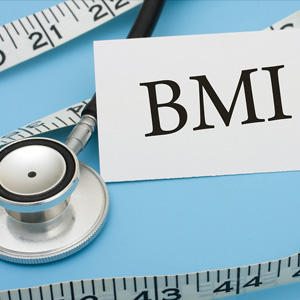Bye, Bye, BMI?

Now that obesity has been classified as a disease by the American Medical Association, it’s important to look at how obesity is measured and then decide if BMI (Body Mass Index)—currently the most popular measuring system—is indeed accurate.
BMI or Body Mass Index is the most popular tool used by medical professionals in assessing obesity in adults. BMI, which is derived by dividing one’s body weight in kilograms by height in meters squared (BMI=kg/m2), has its advantages and disadvantages. Even though BMI is a convenient tool, it is a general predictor of an individual’s risk of developing chronic disease and health problems based on excess weight one is carrying and it does not distinguish between lean muscle mass and fat mass. With BMI, individuals are vaguely classified under certain categories such as underweight, normal, overweight, and obese. A reading above 25 is considered overweight and above 30 is considered obese.
Since BMI doesn’t distinguish between fat and muscle weight, a lean, fit individual or an athlete with a high amount of muscle mass can be classified as being overweight or obese, whereas in reality they may have a relatively low level of body fat and be at low risk for disease.
Waist circumference and waist to hip ratio is another method used to determine abdominal obesity. Those with more weight around their waists are at a higher risk for disease than those who carry their weight around their hips. Women with a waist size over 35 inches and men with a waist size over 40 inches are at increased risk.
Skinfold measurement is a system mainly used by fitness professionals to measure body fat. This system requires taking measurements of skinfold thickness at standard sites around the body with a set of calipers. Skinfold testing, which requires having a certain amount of skill and practice by the tester, also has its limitations, as results can vary among different testers. This process can also be invasive and uncomfortable for certain clients because it requires stripping down so that measurements can be taken.
Bioelectrical impedance analysis (BIA) is also a very popular method used to measure body fat. In BIA, a (painless) current is passed through the body measuring water content in both fat and lean muscle tissue. Lean muscle tissue holds more water and therefore is a better conductor of the electric current, whereas fat tissue has less water and is not a good conductor of the current. Body fat is then calculated by measuring the resistance to the flow of the electric current. BIA can be done by a health care provider, which is more sophisticated, or simply be measured on your bathroom scale, as most home scales now provide this option. Anything above 35 percent for women and 25 percent for men is considered obese.
Finally, hydrostatic weighing, which has been long considered as the ‘gold standard’ of measuring body fat, has its pitfalls, too, as it requires the person to be submerged in a tank of water in an uncomfortable manner. This method is not practical and readily accessible as these tanks are located mainly at universities and research institutes.
While none of the above methods are 100 percent accurate, it seems that the BMI system is the most inaccurate of all and yet continues to be the most widely used. BMI does not give any indication of one’s body fat, which is a risk factor for many diseases. Maybe it’s time that health care providers ditch this age-old method completely and focus more on BIA and waist circumference and waist to hip ratio, as a combination of these two methods would provide the optimal measurement.
[Aarti Patel serves as the columnist for Fitness Lifestyle. She has a B.Sc. in Health Information Administration and is certified by the American Council on Exercise as a Personal and Group Fitness Instructor, and Lifestyle and Weight Management Coach. She can be reached at 404-376-5655; info@aartifitness.com. This column rotates monthly along with the Ask the Doctor column by Gulshan Harjee, M.D.]
Enjoyed reading Khabar magazine? Subscribe to Khabar and get a full digital copy of this Indian-American community magazine.
blog comments powered by Disqus












